Calibrating the separation scale
1) Pick several stars from a list of calibration doubles. The table on page 3 of Ronald Charles Tanguay's article "Observing Double Stars for Fun and Science" is an excellent resource. Look for wider doubles to help reduce estimating errors.
2) Rotate the eyepiece so that the long central scale is aligned parallel to the double you are sampling. Aim your scope so that either the primary or secondary star is aligned with one of the marks on the scale.
3) Note the number of marks from primary to secondary. Try to measure as accurately as possible--within a fraction of a mark if possible.
4) Compare the measurements to the actual separation of the standard doubles by dividing the official separation by the number of marks measured for that star to yield the number of arc-seconds per mark. (e.g. 61 arc-seconds divided by 7.1 marks = 8.6 arc-seconds per mark.)
5) Compare the results of several stars and discard any obviously erroneous measurements. Average the rest of the measurements together to arrive at a scale for your eyepiece/barlow/telescope combination.
Measuring Double Stars with the Astrometric Eyepiece
Measuring Position Angle
1) Align the pointer to the 270 degree mark on the protractor and lock down the eyepiece in the barlow.
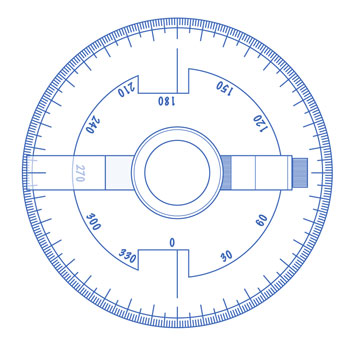
2) Disengage the RA clutch and let the stars drift through the field.
3) Loosen the locking screw on the focuser and rotate barlow+eyepiece as a unit until the stars drift parallel to the central scale and EXIT the side marked 270 degrees on your protractor scale.
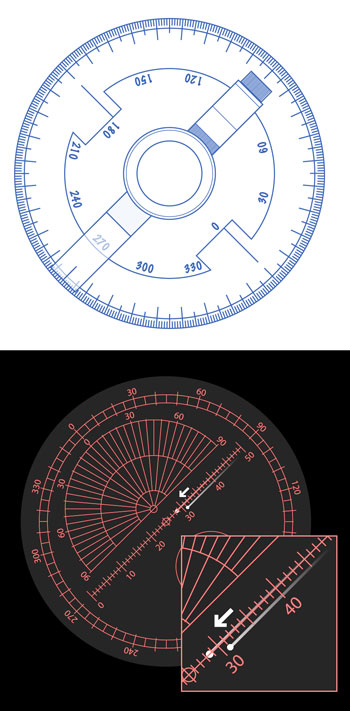
4) Tighten the locking screw on the focuser to lock in the 270° position angle.
By locking the eyepiece and protractor at this point, you have calibrated your center scale to the known value of 270 degrees. In the next steps, you will turn just the astrometric eyepiece and the pointer taped to it so that the center scale lines up with the stars in the double. By leaving the barlow and protractor fixed, your calibration will remain intact.
5) Aim the scope so that the double is close to the central scale and engage the RA clutch.
6) Loosen the barlow locking screw and rotate eyepiece until the central scale is parallel to the PA of the double. Make sure the pointer you taped to the eyepiece aims from the primary star TOWARD the secondary star. When you are satisfied with the alignment, tighten the barlow locking screw.
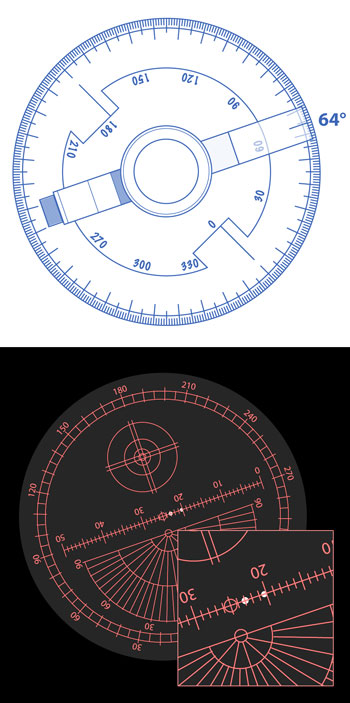
To be sure that your reading is not off by 180 degrees, it is important that the secondary star is on the same side of the eyepiece that the pointer is taped.
7) Read pointer position on protractor to get the PA value. (Be sure the protractor is correctly marked for standard PA convention.)
Measuring Separation
1) After measuring the PA of a double, move the double so that the primary or secondary is aligned with one of the marks on the central scale.
2) Note the number of marks from the primary to the secondary within a fraction of a mark if possible.
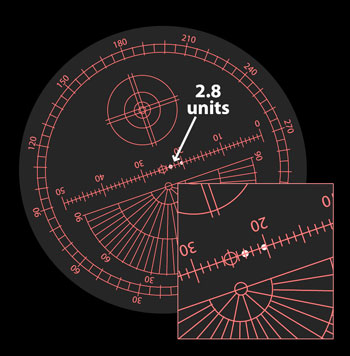
3) Multiply the number of rules by the calibration number you already arrived at for your eyepiece/barlow/telescope combination. This is your observed separation for the double.
Making multiple measurements and averaging them will provide better results.
I'm interested in any comments on this method--whether I'm leaving out any important parts of the process, or if I've made it unnecessarily complicated in places.
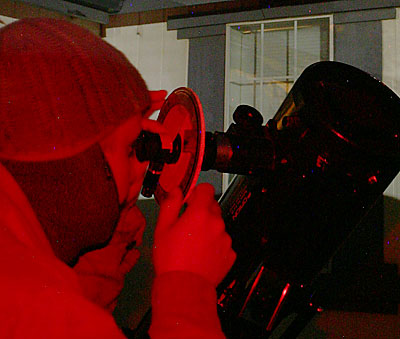
-- PAGE 1 OF 3 || PAGE 2 OF 3 --





Thank you for a very informative "how-to" article that has given me an insight to measuring double stars PA & Sep.
Don, thank you for your comment. I hope you get a chance to measure some doubles soon.
Jeremy
Brilliant article! Thank you.
S.Johnson,UK
Very interesting article. I'm currently working on the AL dbl star list and a bit confused about the cardinal directions in the FOV with the 8" SC I'm using. I'll have to make one of the protractor gadgets and borrow an astrometric EP. Very nice tutorial!
I wonder about a drifting star always pointing W, when using anything other than an EQ mount. Seems it would depend on what part of the sky you're looking in and that it also might contain a N or S component to it. Hmm. . have to do some experimenting with this. I don't own an EQ mount. Great work!
Hi Markstar, I'm glad you found the tutorial helpful. A star drifting through the field of any undriven telescope will always move toward celestial west. (Celestial west does not always relate intuitively to terrestrial west, especially near the celestial pole.) I have a brief description about determining celestial compass points when viewing through the eyepiece here: Establishing Cardinal Directions. Double star measurements are also possible through non-equatorial telescopes, although it's not as accurate.
I hope you enjoy the doubles and multiples in the AL list as much as I have.
Steady skies,
Jeremy
Jeremy, OK I have a better understanding after using Starry Night awhile, turning on RA/Dec circles, flipping the view horizontally, using the angular sep tool, and speeding up time. Your comment that Celestial dir. do not always relate intuitively to terrestrial dir was most helpful. Finally I'm begining to see the big picture after all the stars are connected. Lots to think about!
I've borrowed a a Celestron 12.5mm Micro-Guide EP and downloaded the instruction manual, which explains a lot. Good info there! Look forward to using it and making myself a protractor set up.
Much thanks!
That's a great idea to use Starry Night in fast-motion to visualize what's happening. Have fun setting up the PA protractor and measuring some doubles!
Brilliant Article! Thank you. D M. HARLEY U.k....
Excellent Article!! Do you have a printer friendly version of the entire article (including pictures) or perhaps a pdf? I'd like to save it for offline reading, and it would be a handy quick reference at the scope.